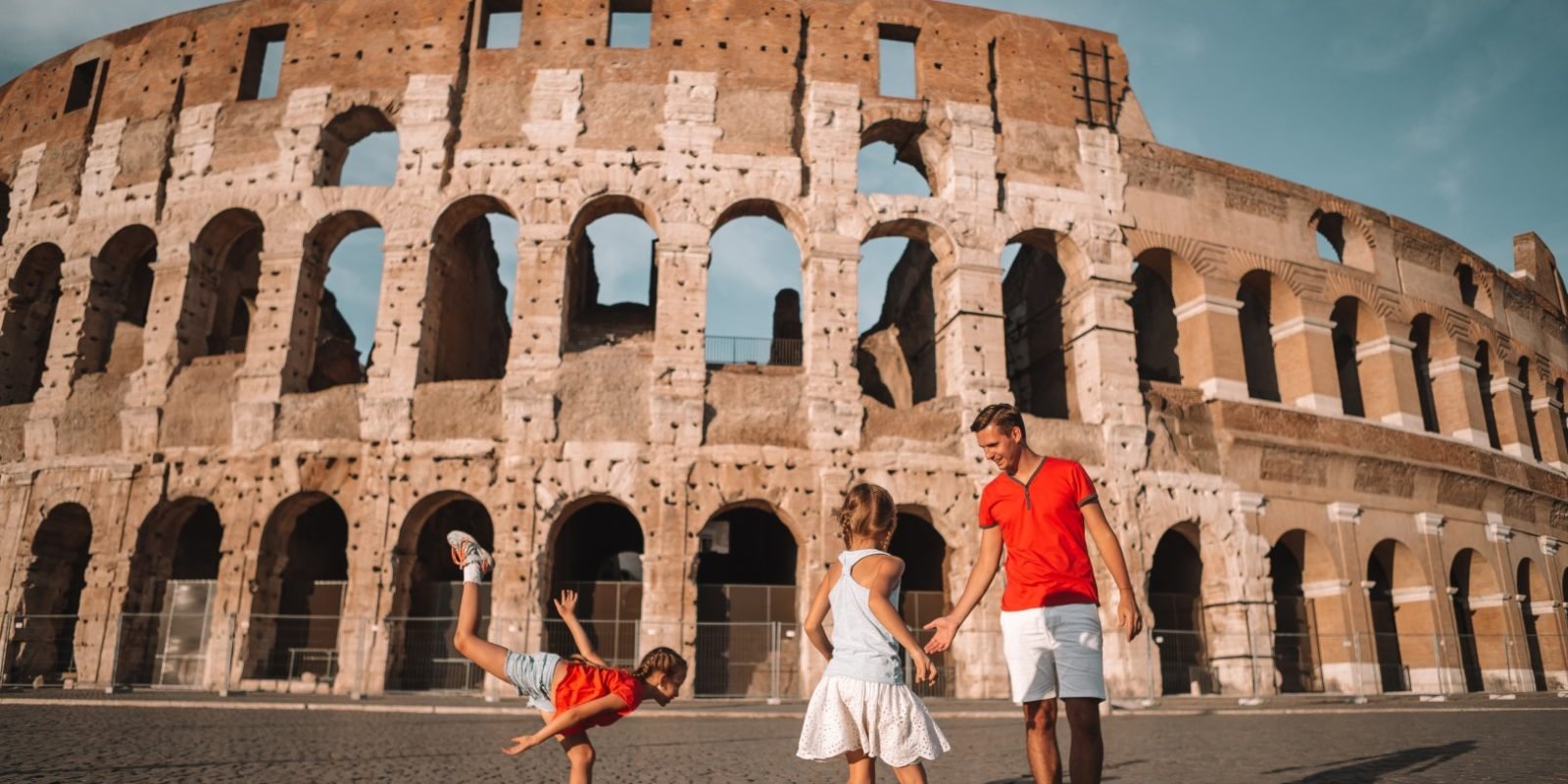Planning a family trip can be both exciting and challenging, especially when choosing the right destination. Rome, often referred to as the “Eternal City,” offers a rich blend of history, culture, and adventure that can captivate travelers of all ages. From ancient ruins to world-class museums, Rome has something to offer for everyone, and is a must-visit destination if you’re traveling to Italy with kids. We will guide you through a comprehensive itinerary for a family trip to Rome, highlighting the best places to visit, where to stay, where to eat, how to get around, and much more.
Things to Do in Rome with Kids
Rome provides numerous family-friendly activities that can make your trip memorable and enjoyable for both children and adults. Here are some top things to do during your family trip to Rome:
- Explore the Colosseum: Begin your Roman adventure by visiting the iconic Colosseum. Kids will be fascinated by the grandeur and history of this ancient amphitheater. Consider joining a guided tour or using an audio guide to enhance the experience.
- Discover Ancient Rome at the Roman Forum: Adjacent to the Colosseum lies the Roman Forum, a sprawling archaeological site that showcases the heart of ancient Rome. Wander through its ruins, marvel at the Temple of Saturn, and imagine what life was like thousands of years ago.
- Visit the Vatican City: Don’t miss the opportunity to explore the Vatican City, home to St. Peter’s Basilica and the Vatican Museums. Climb to the top of St. Peter’s Dome for breathtaking views of Rome. Make sure to book skip-the-line tickets in advance to avoid long queues.
- Experience the Pantheon: The Pantheon, a well-preserved Roman temple, is a must-visit for its architectural marvel. Kids will be intrigued by the giant dome and the “oculus” opening at the top, allowing sunlight to illuminate the interior.
- Enjoy a Gelato Treat: Rome is famous for its gelato, and indulging in this delicious treat is a must for the whole family. Find a reputable gelateria and savor the flavors of Italian gelato while strolling through the charming streets of Rome.
Want to know more? Check out our comprehensive guide to What to Do in Rome With Kids
Best Places to Visit in Rome
In addition to the specific attractions mentioned above, Rome offers a plethora of remarkable places to visit that cater to both adults and children. Here are a few more family-friendly destinations in Rome:
- Villa Borghese: Escape the hustle and bustle of the city and enjoy the peaceful surroundings of Villa Borghese. This large park offers beautiful gardens, a lake with rowing boats, a zoo, and the renowned Borghese Gallery, which houses a remarkable collection of art.
- Explora Children’s Museum: Perfect for families with young children, the Explora Children’s Museum is an interactive and educational space where kids can learn through play. It features hands-on exhibits and activities designed to stimulate their curiosity and creativity.
- Bioparco di Roma: Take a walk on the wild side at the Bioparco di Roma, a zoological garden located within Villa Borghese. Kids will love seeing a variety of animals, including elephants, giraffes, lions, and more.
- Appian Way: Step back in time by visiting the Appian Way, one of the most important ancient Roman roads. Rent bikes or join a guided tour to explore this historic route, lined with ancient ruins and tombs.
Check out our guide on the Top Rome Tourist Attractions.
Where to Stay in Rome with Kids
Choosing the right accommodation is crucial for a successful family trip to Rome. Consider the best neighborhoods to stay in Rome that are convenient and family-friendly:
- Trastevere: Known for its picturesque streets and vibrant atmosphere, Trastevere offers a great selection of family-friendly hotels and apartments. It is within walking distance of many attractions and has a charming, local feel.
- Vatican City: If you plan to spend a significant amount of time exploring the Vatican and its surroundings, staying near Vatican City can be a convenient option. This area has several hotels that cater to families and provides easy access to the Vatican Museums and St. Peter’s Basilica.
- Monti: Monti is a trendy neighborhood located near the Colosseum and the Roman Forum. It offers a variety of accommodations, including family-friendly hotels and vacation rentals. Monti is known for its authentic Roman feel and its proximity to popular attractions.
Want to see more options? Read our guide on Where to Stay in Rome With a Family
Looking for specific hotels? Check out our list of the Best Value Hotels in Rome for Families.
Where to Eat in Rome with Kids
Italian cuisine is beloved worldwide, and Rome is a food lover’s paradise. When it comes to dining with kids, finding restaurants that cater to their tastes and offer a relaxed atmosphere is essential. Here are a few suggestions for best places to eat in Rome:
- Pizzeria da Baffetto: Located in the heart of Rome, Pizzeria da Baffetto is renowned for its delicious thin-crust pizzas. The casual setting and fast service make it an ideal spot for families.
- La Gelateria Frigidarium: Treat your taste buds to mouthwatering gelato at La Gelateria Frigidarium. Located near Piazza Navona, this gelateria offers a wide range of flavors, including dairy-free options.
- Roscioli: For a more upscale dining experience, Roscioli is a fantastic choice. This delicatessen and restaurant serve traditional Roman cuisine, including pizza, pasta, and antipasti. The welcoming atmosphere makes it suitable for families.
Looking for more options? Check out our guide on the Best Areas to Eat in Rome
When to Go to Rome
Rome can be visited year-round, but the best time to visit Rome depends on your preferences and the weather conditions you prefer. Spring (April to June) and fall (September to October) are generally considered the ideal seasons to visit for your family trip to Rome. The weather is pleasant, and the city is less crowded compared to the summer months. However, keep in mind that spring and fall are also popular tourist seasons, so expect larger crowds compared to winter.
Summer (July to August) is the peak tourist season in Rome. The city can be hot and crowded during this time, but it offers longer daylight hours and the chance to experience various outdoor festivals. Winter (December to February) is the low tourist season in Rome, and you can find better deals on accommodation. However, the weather can be cold and rainy, and some attractions may have shorter opening hours.
Bringing your little one? Read our guide on Rome With a Toddler
How Long to Stay in Rome
The duration of your family trip to Rome depends on the number of attractions you want to visit and the pace at which you prefer to explore. However, a minimum of three to four days is recommended to fully experience the highlights of the city. This timeframe allows you to visit the major attractions, take leisurely walks through the charming neighborhoods, and savor the local cuisine. If you have more time, consider extending your stay to explore Rome’s lesser-known gems and take day trips to nearby destinations, such as Pompeii or Tivoli.
Rome Itinerary with Family
To make the most of your family trip to Rome, here’s a sample itinerary that covers the essential sights and offers a balanced mix of activities for both kids and adults:
Day 1:
- Morning: Explore the Colosseum and the Roman Forum.
- Afternoon: Take a leisurely walk to Capitoline Hill and visit the Capitoline Museums.
- Evening: Stroll through the charming streets of Trastevere and enjoy a family dinner at a local trattoria.
Day 2:
- Morning: Visit the Vatican City and explore St. Peter’s Basilica.
- Afternoon: Discover the Vatican Museums, including the Sistine Chapel.
- Evening: Enjoy a relaxing walk along the Tiber River and stop for gelato at one of Rome’s famous gelaterias.
Day 3:
- Morning: Take a guided tour of the Pantheon and explore the surrounding area.
- Afternoon: Visit Villa Borghese and enjoy a picnic in the park.
- Evening: Experience the vibrant atmosphere of Piazza Navona and dine at a family-friendly restaurant.
Day 4:
- Morning: Explore the Appian Way and visit the Catacombs of San Callisto.
- Afternoon: Take a leisurely walk through the charming Monti neighborhood and visit the Basilica di Santa Maria Maggiore.
- Evening: Enjoy an authentic Roman dinner at a traditional osteria.
Only have 3 days? Read our itinerary for 3 Days in Rome With Family
How to Get to Rome
There are several ways to get to Rome, depending on your location and preferences. Here are common methods of transportation:
- By Air: Rome has two major international airports, Fiumicino Airport (Leonardo da Vinci Airport) and Ciampino Airport. Numerous airlines operate flights to Rome from various cities worldwide.
- By Train: Rome is well-connected to other European cities through an extensive rail network. The city has several train stations, including Roma Termini, which is the main hub for both domestic and international train services.
- By Car: If you prefer a road trip, you can reach Rome by car. Italy has a well-maintained highway system, and there are multiple highways leading to Rome. However, consider traffic and parking challenges in the city.
- By Bus: Rome is also accessible by bus from various European destinations. Several bus companies offer long-distance routes to the city.
- By Cruise: If you’re on a Mediterranean cruise, Rome is a common port of call. Cruise ships dock at the Civitavecchia port, and you can easily reach Rome by train or private transfer.
How to Get Around Rome
Rome has a well-connected public transportation system that makes getting around the city relatively easy. Here are the main modes of transportation to consider:
- Metro: Rome has a three-line metro system that covers most of the city’s popular areas and attractions. The metro is a convenient option for traveling longer distances quickly.
- Buses: Rome has an extensive bus network that reaches areas not covered by the metro. Buses are a good option for shorter distances and provide a chance to see more of the city.
- Trams: Trams operate on several routes in Rome and can be a convenient means of transportation, particularly for reaching areas with heavy traffic.
- Walking: Rome’s historic center is compact and best explored on foot. Many of the major attractions are within walking distance of each other, and wandering through the city’s charming streets allows you to discover hidden gems along the way.
Want more details? Read our guide on Best Ways to Get Around in Rome
How Much to Travel to Rome with Kids
The cost of a family trip to Rome can vary depending on several factors, including the time of year, accommodation choices, dining preferences, and the activities you plan to undertake. However, here’s a general breakdown of the main expenses to consider:
- Accommodation: Family-friendly hotels in Rome can range from budget options to luxury establishments. On average, expect to spend around $100 to $300 per night for a standard hotel room that accommodates a family of four.
- Meals: Dining out in Rome can be affordable if you choose local trattorias and pizzerias. A family meal at a mid-range restaurant can cost between $50 to $100, including drinks.
- Attractions: Most major attractions in Rome have an entrance fee. The cost can range from $10 to $30 per person, depending on the attraction. Some attractions offer discounted or free admission for children.
- Transportation: A single metro or bus ticket in Rome costs around $1.50, but it’s advisable to purchase daily or multi-day passes for unlimited travel. A 72-hour travel card for all public transportation costs approximately $22 per person.
- Extras: Additional expenses may include guided tours, souvenirs, gelato treats, and any day trips or excursions you choose to undertake.
A family trip to Rome can be an enriching and unforgettable experience. From exploring ancient ruins to indulging in gelato, the Eternal City offers a perfect blend of history, culture, and culinary delights. By planning your itinerary wisely, considering family-friendly accommodations and restaurants, and using the efficient public transportation system, you can create lifelong memories while discovering the wonders of Rome with your loved ones. So pack your bags, embrace the adventure, and get ready to immerse yourselves in the beauty of this eternal city.
FAQs
Is Rome good for a family holiday?
Yes, Rome is an excellent destination for a family holiday. The city offers a wide range of attractions and activities that cater to all ages, making it an enjoyable experience for both children and adults. Rome is filled with fascinating historical sites like the Colosseum, Roman Forum, and Vatican City, providing educational and cultural experiences for kids. Additionally, there are family-friendly museums, parks, and interactive exhibits like the Explora Children’s Museum and Villa Borghese, where kids can have fun while learning.
Rome also has a vibrant atmosphere, charming streets, and delicious cuisine, including kid-friendly options like pizza and gelato. The city is known for its warm hospitality and welcoming attitude towards families, ensuring a comfortable and enjoyable stay. With reliable public transportation and a compact city center, it’s easy to navigate and explore the attractions, even with children in tow.
Moreover, Rome’s central location in Italy allows for day trips to nearby destinations, such as Pompeii or the beautiful countryside of Tuscany, adding more variety to your family holiday. So you must bring your kids on your family trip to Rome.
Is Rome okay for kids?
Yes, Rome is definitely great for kids! The city has plenty of attractions and activities that cater to children, ensuring they have a fun and engaging experience. Here are some reasons why Rome is suitable for kids:
- Fascinating Historical Sites: Kids can explore ancient wonders like the Colosseum and Roman Forum, igniting their imagination and providing a hands-on history lesson. The grandeur and stories behind these iconic sites can captivate young minds.
- Vatican City: Visiting the Vatican can be an exciting experience for kids. They can marvel at the grand St. Peter’s Basilica, climb to the top of St. Peter’s Dome for panoramic views, and be awestruck by the stunning artworks in the Vatican Museums, including the famous Sistine Chapel.
- Interactive Museums and Exhibits: Rome offers interactive museums and exhibits designed specifically for children. The Explora Children’s Museum, for example, provides a hands-on learning experience where kids can engage in various activities, experiments, and games.
- Gelato and Pizza: Italian cuisine is loved by people of all ages, and Rome is famous for its delicious gelato and pizza. Kids can indulge in these treats and explore various flavors while exploring the city.
- Parks and Outdoor Spaces: Rome has beautiful parks and outdoor spaces where kids can run, play, and enjoy the fresh air. Villa Borghese, with its gardens, playgrounds, and a lake for boat rides, is a popular spot for families to relax and have picnics.
- Family-Friendly Accommodations and Services: Rome has numerous family-friendly hotels and accommodations that offer amenities and services catering to children’s needs. Many hotels provide babysitting services, family rooms, and kid-friendly facilities to ensure a comfortable stay for families.
- Cultural Learning Opportunities: Rome presents an excellent opportunity for children to learn about different cultures, art, and history. Exposing kids to diverse experiences can broaden their horizons and nurture their curiosity.
Is there anything for kids to do in Rome?
Yes, there are plenty of things for kids to do during your family trip to Rome! The city offers a range of activities and attractions that cater to children’s interests and ensure they have a memorable and enjoyable time. Here are some kid-friendly activities in Rome:
- Explora Children’s Museum: The Explora Children’s Museum is a hands-on, interactive museum designed specifically for kids. It offers various exhibits and activities that encourage learning through play, fostering curiosity and creativity.
- Gladiator School: Kids can step back in time and experience what it was like to be a gladiator at Gladiator School. They can learn about ancient Roman combat techniques, dress up in gladiator attire, and participate in mock battles.
- Villa Borghese Park: Villa Borghese is a vast park in the heart of Rome, offering ample space for kids to run, play, and enjoy outdoor activities. The park features playgrounds, a carousel, a lake for boat rides, and even a small zoo (Bioparco) where kids can see various animal species.
- Time Elevator Rome: The Time Elevator Rome is a multisensory experience that takes visitors, including kids, on a virtual journey through the city’s history. It combines 3D visuals, motion seats, and special effects to provide an entertaining and educational experience.
- Gladiator Shows: Several venues in Rome offer live gladiator shows where kids can witness exciting combat reenactments. These shows provide an entertaining way for children to learn about ancient Roman history and culture.
- Rome Zoo (Bioparco): Located within Villa Borghese, the Rome Zoo (Bioparco) is home to a wide variety of animals from around the world. Kids can enjoy observing and learning about different species, making it a fun and educational experience.
- Puppet Theater (Teatro di Pulcinella al Gianicolo): Puppet shows are a popular form of entertainment in Italy, and the Puppet Theater at Gianicolo Hill in Rome offers delightful performances for kids. They can enjoy traditional Italian puppetry and captivating storytelling.
- Borghese Gardens Bike Rental: Renting bicycles and exploring the vast Borghese Gardens can be a fun family activity. Kids can pedal through the park, enjoy the scenic views, and have a picnic along the way.
Is Rome an expensive holiday?
Rome can be considered a moderately expensive holiday destination, but the cost will depend on various factors such as your accommodation choices, dining preferences, activities, and overall travel style.
What is the cheapest month in Rome?
In general, for your family trip to Rome, the cheapest months to visit in terms of accommodations and airfare are typically the low-season months of January and February. During these months, tourism in Rome tends to be less crowded, and prices for hotels and flights are often lower compared to the peak tourist season.
Additionally, November and March can also be relatively affordable months to visit Rome, as they fall within the shoulder season. During these months, the weather is generally milder, and prices may be more favorable compared to the peak summer season.
Are children free on Rome Metro?
Children under the age of 10 can travel for free on the Rome Metro when accompanied by an adult. This includes both the Rome Metro subway system (Line A, Line B, and Line C) and the Rome Metro trams (Line 2, Line 3, Line 5, and Line 8). Children must be accompanied by an adult with a valid ticket or pass, and they can travel without a separate ticket or pass of their own. It’s worth noting that this policy applies specifically to the Rome Metro system, and there may be different rules and fares for other forms of public transportation in Rome, such as buses or regional trains.
Should I spend more time in Rome or Florence?
Deciding how much time to spend in Rome versus Florence depends on your personal preferences and interests. Both cities offer unique experiences and attractions, so it’s worth considering what you hope to get out of your visit. Here are some factors to consider when deciding how to allocate your time:
Rome:
- Historical and Cultural Richness: Rome is home to iconic landmarks such as the Colosseum, Roman Forum, and Vatican City. The city is steeped in history, offering a wealth of ancient ruins, Renaissance art, and architectural marvels.
- Size and Scope: Rome is a large city with numerous attractions to explore. It requires more time to cover the main highlights, including the Vatican Museums, St. Peter’s Basilica, and the Sistine Chapel. Additionally, Rome’s sprawling nature means there’s plenty to see and do beyond the famous sites.
- Vibrant Atmosphere: Rome exudes a bustling, energetic ambiance with its lively piazzas, charming streets, and vibrant local culture. The city’s culinary scene is renowned, offering a wide range of dining options.
Florence:
- Art and Culture: Florence is known as the birthplace of the Renaissance and is home to world-class art galleries and museums, including the Uffizi Gallery and the Accademia Gallery (home to Michelangelo’s David). The city’s historic center is a UNESCO World Heritage site.
- Compact and Walkable: Florence is a relatively small and walkable city, making it easier to explore its major attractions in a shorter amount of time. The city’s compact size also allows for a more relaxed pace of sightseeing.
- Tuscan Charm: Florence offers a charming ambiance with its picturesque streets, elegant architecture, and views of the Arno River. The city is renowned for its artisanal traditions, including leatherwork, ceramics, and jewelry.
Considering the factors above, if you have a deep interest in ancient history, art, and the grandeur of the Roman Empire, allocating more time to Rome would be beneficial. On the other hand, if you have a specific interest in Renaissance art and prefer a smaller, more intimate city atmosphere, spending more time in Florence would be a great choice.
If possible, it’s recommended to allocate at least 3-4 days to Rome and 2-3 days to Florence to get a decent taste of both cities. However, if you have limited time, it’s still possible to experience the highlights of each city within a shorter timeframe. Ultimately, the decision should be based on your personal preferences, the pace of your trip, and the experiences you prioritize.




